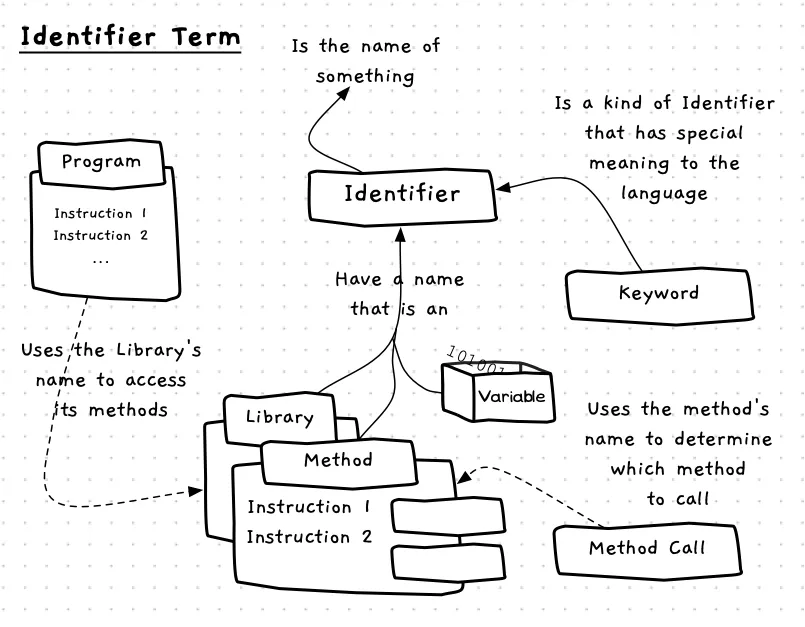Identifier
Identifier is the term for the name/word that identifies something for the compiler. This could be the name of a building block (such as a variable, constant, or method) or words that have special meaning for the compiler. You use identifiers to name the things (building blocks) you create, and to refer to those you want to use.
As identifiers are used to name building blocks, the overall concept relates to many others. The concept map below shows some of the key relations based on what we have learned so far.

Identifiers — when, why, and how
Building a digital reality will require you to name things within it. As a result, identifiers are really important. The names you give the building blocks you create will help shape how others interact with your code and its concepts.
In general, you want to name things to accurately capture the thing you are building. Keeping names clear and accurate will greatly help you and others work with your code.
Programming languages require you to name things without spaces so that the compiler can easily know when an identifier starts and ends. However, most of the time you will need more than one word to be clear and accurate. To achieve this there are several common formats for identifiers:
- UPPER_CASE: all upper case letters with underscores (
_) to separate words. - snake_case: all lower case letters with underscores to separate words.
- camelCase: start with a lower case character and use an upper case character for each new word.
- PascalCase: use an upper case character at the start of each word.
- kebab-case: all lower case letters with hyphens (
-) to separate words.
Every programming language has coding conventions that indicate which format to use for identifiers for different building blocks. In C# the conventions are to use:
- PascalCase for methods.
- camelCase for variables.
- UPPER_CASE for constants.
In C#
We used this as our example when discussing how to read syntax diagrams. For a quick recap, in C#:
- Identifiers must start with an underscore (
_) or a letter. This is because the compiler needs a way of distinguishing identifiers from numbers entered directly into the code. - An identifier can not contain spaces, or special characters other than underscores.
- After the first character, an identifier can contain zero or more additional characters which are letters, digits, or underscores.
Keywords
While you can name the building blocks in your program almost anything, there are some reserved words that have special meaning to the language. These are called keywords. You cannot use these — they are taken for another purpose.
Most of the time this doesn’t cause any issues, but sometimes you have to work around it. For example class is taken, so you can’t call anything a class which can be a pain if you are building education related software.
The keywords in C# are listed in the table below. All of these are valid identifiers according to our syntax rule, you just can’t use them to name things.
| Reserved Identifiers (Keywords) |
|---|
abstract, as, base, bool, break, byte, case, catch, char, checked, class, const, continue, decimal, default, delegate, do, double, else, enum, event, explicit, extern, false, finally, fixed, float, for, foreach, goto, if, implicit, in, int, interface, internal, is, lock, long, namespace, new, null, object, operator, out, override, params, private, protected, public, readonly, ref, return, sbyte, sealed, short, sizeof, stackalloc, static, string, struct, switch, this, throw, true, try, typeof, uint, ulong, unchecked, unsafe, ushort, using, virtual, void, volatile, while |
Examples
Some example valid identifiers that may be useful for naming things:
| Example Identifiers |
|---|
DrawGame, PlaySplashScreen, AirSpeed, WriteLine, ReadLine, Bitmap, SoundEffect, name, DrawBitmap, age, player, height, test, cost, name3, _23, i |
Activities
Which of the following names are valid identifiers in C# and why/why not?
____ _2_heighta2-heightyHEIGHT_Aclass
Answers
- 1: A single underscore is a valid ientifier.
- 2: Two consecutive underscores is a valid identifier.
- 3: This identifier is invalid because it contains spaces.
- 4: This identifier is invalid because it begins with a number.
- 5: This identifier is invalid because it contains a hyphen.
- 6: A single character is a valid identifier.
- 7: This is a valid identifier because it begins with a letter and contains only letters and underscores.
- 8: This is a valid identifier, but you cannot use it to name anything you create as it is a keyword.